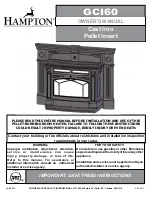
STUFE OLIVIa-BETTy-anTOnIa-STEFanIa-CLaRaBELLa
cod. 004770030 - 12/2007
3/44
GB
d
The heating appliances (hereafter referred to as “stoves”)
from PaLaZZETTI LELIO S.p.a. (hereafter referred to as
PaLaZZETTI) of the series OLIVIa, BETTy, anTOnIa,
STEFanIa, CLaRaBELLa are manufactured and tested
in accordance with the safety requirements set forth by
applicable European standards.
This manual is for owners of the stove, and installers,
operators and maintenance engineers of the OLIVIa,
BETTy, anTOnIa, STEFanIa, CLaRaBELLa wood
burning stoves.
If you have any doubts about the contents or need some
clarifications, do not hesitate to contact the manufacturer
or an authorised technical assistance centre, giving the
number of the paragraph in question.
The printing, translation and reproduction, in whole or in
part, of this manual require authorization by
Palazzetti. authorisation.
The technical information, graphs and specifications in
this manual are not to be disclosed.
duaL comBustIon system
In a wood burning stove, a correctly burning flame emits the same
amount of carbon dioxide (CO
2
) as would be emitted through
the natural decomposition of the wood itself.
The quantity of CO
2
produced by combustion or decomposition
of a tree corresponds to the quantity of CO
2
that the tree itself is
capable of extracting from the environment and transforming into
oxygen for the air and carbon for itself during its lifetime.
Unlike wood, when fossil fuels are burned – which are not
renewable, like coal, diesel oil, gas - a huge amount of C0
2
accumulated in the course of millions of years is emitted into the
atmosphere, increasing the green-house effect. Consequently,
the use of wood as fuel maintains the perfect equilibrium of nature
because it is a renewable fuel whose burning is compatible with
nature’s life cycle.
The principle of
clean combustion
is in perfect harmony with
these characteristics and Palazzetti always refers to it when
designing its products.
What exactly do we mean by
clean combustion
and how does it
come about? By controlling the flow of primary air and by adding
secondary air, a second level of combustion, or post-combustion,
takes place. This is indicated by a second characteristically
clearer and stronger flame above the main flame. By adding new
oxygen, this flame consumes the unburned gasses, remarkably
improving heat production and reducing the harmful emission
of CO (carbon monoxide) caused by incomplete combustion.
This is a unique feature of the stoves and other PaLaZZETTI
products.
Die Heizgeräte (nachfolgend “Heizöfen” genannt) der
PaLaZZETTI LELIO S.p.a. (nachfolgend PaLaZZETTI)
Serie OLIVIa, BETTy, anTOnIa, STEFanIa,
CLaRaBELLa sind gemäß den Sicherheitsvorschriften
der betreffenden Europäischen Richtlinien hergestellt
und endgeprüft.
Dieses Handbuch richtet sich an den Eigentümer des
Heizofens Mod. OLIVIa, BETTy, anTOnIa, STEFanIa,
CLaRaBELLa sowie an die Installateure, Bediener und
das Wartungspersonal.
Im Zweifelsfalle bzw. für jede weitere Erklärung zum
Handbuch ist mit dem Hersteller oder der befugten
Kundendienststelle Kontakt aufzunehmen. Dabei bitte
die absatznummer und das betreffende argument
angeben.
Der Druck, die Übersetzung und auch nur die teilweise
Vervielfältigung dieses Handbuchs unterstehen der
Genehmigung seitens der Fa. Palazzetti.
Die in diesem Handbuch enthaltenen technischen
Informationen, grafischen Darstellungen und
Spezifikationen dürfen nicht verbreitet werden.
das system der doPPeLten
verBrennunG
Eine in einem Heizofen korrekt brennende Flamme gibt die
gleiche Menge an Kohlendioxyd (C02) ab, die durch die
natürliche Zersetzung des Holzes selbst hätte erzeugt werden
können.
Die von der Verbrennung oder Zersetzung einer Pflanze
erzeugte C02-Menge entspricht der Menge, die eben diese
Pflanze während ihres Lebenszyklus aus der atmosphäre
entnimmt und für die Luft in Sauerstoff bzw. für die Pflanze in
Kohlenstoff umwandeln kann.
Bei der Verwendung von nicht erneuerbaren
Fossilbrennstoffen
(Kohle, Dieselöl, Gas) werden im Gegenteil zum Holz enorme
Mengen an CO2, das sich im Laufe von Millionen Jahren
angesammelt hat, an die atmosphäre abgegeben,was zur
Erhöhung des “Treibhauseffekts” beiträgt. Demnach kann
die anwendung von Holz als Brennstoff als umweltfreundlich
angesehen werden, da ein erneuerbarer Brennstoff verwendet
wird, der sich harmonisch in den natürlichen, ökologischen
Zyklus einfügt.
Das von Palazzetti für Kaminöfen und Kamine angewandte
Prinzip der sauberen Verbrennung entspricht voll und
ganz
diesen Zielsetzungen, woran man sich auch in der Planung der
Produkte hält.
Was versteht man unter sauberer Verbrennung
und wie funktioniert sie? Die Kontrolle der Primärluft und die
Zufuhr von Sekundärluft bewirken eine zweite Verbrennung bzw.
eine so genannte nachverbrennung, bei der sich eine zweite
Flamme über der ersten entwickelt und lebendiger und auch
klarer brennt. Sie verbrennt durch die Zufuhr der Sekundärluft
die unverbrannten Gase, wodurch die Heizleistung wesentlich
verbessert wird: die schädlichen, durch die unvollständige
Verbrennung bedingten CO-Emissionen (Kohlenmonoxyd)
werden auf ein Minimum reduziert. Es
h a n d e l t s i c h
hierbei um ein exklusives Merkmal der Heizöfen und anderer
Produkte der Fa. PaLaZZETTI.
Содержание BETTY
Страница 7: ...STUFE Olivia Betty Antonia Stefania CLARABELLA cod 004770030 12 2007 44...
Страница 42: ......
Страница 43: ......




































